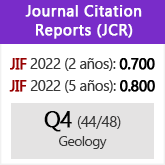New suoid specimens from Gebel Zelten, Libya
DOI:
https://doi.org/10.3989/egeol.0662147Palabras clave:
Suoidea, Mioceno Medio, Libia, Megalochoerus, Libycochoerus, Diamantohyus, dimorfismo sexualResumen
Una limitada colección de suoideos procedentes de Gebel Zelten fue hecha a finales de los años 1990 por una expedición paleontológica internacional, con participación española y libia. La Dra. Dolores Soria filmó los ejemplares con una cámara de vídeo y tomó las medidas de los dientes con calibre. En este trabajo se utilizan las imágenes filmadas, que, aunque algo limitadas en términos de calidad fotográfica, son interesantes porque representan las primeras conocidas del rostro del suido gigante Megalochoerus khinzikebirus. Las imágenes revelan que básicamente es una versión agrandada de Libycochoerus massai, pero con premolares relativamente más pequeños. Los ejemplares de saniterios fueron fotografiados con una cámara digital Olympus de 1,4 megapixeles, y la calidad de las imágenes son mejores que las de la cámara de vídeo. Estos ejemplares arrojan nueva luz sobre el grado de dimorfismo sexual exhibido por los saniterios, un hecho que había sido previamente inferido sólo a partir de dientes aislados, pero que ahora puede ser confirmado en base a dos fragmentos de mandíbula de Gebel Zelten. Este trabajo está dedicado a la memoria de la Dra. Soria. En este trabajo se consideran algunos huesos postcraneales inéditos procedentes de Gebel Zelten, depositados en el Natural History Museum de Londres y recolectados durante los años 1960 por R. Savage.
Descargas
Citas
Arambourg, C. (1961). Note preliminaire sur quelques vertébrés nouveaux du Burdigalien de Libye. C. R. Somm. Soc. Géol. Fr. 4: 107-108.
Arambourg, C. (1963). Le genre Bunolistriodon. Bull. Soc. Géol. Fr. 5: 903-911.
Besenecker, H. (1973). Neogen und Quartär der Insel Chios (Ägäis). PhD Thesis, Free University Berlin. Colbert, E. (1935). Siwalik mammals in the American Museum of Natural History. Trans. Amer. Philos. Soc. 26: 1-401.
De Bonis, L., Koufos, G., and Sen, S. (1997). The sanitheres (Mammalia, Suoidea) from the Middle Miocene of Chios Island, Aegean Sea, Greece. Rev. Paléobiol. Genève, 16: 259-270.
Deschaseaux, C. (1959). Le genre Doliochoerus. Ann. Paléont. 45: 1-16.
Duncan, R. W. (1974). Reproductive biology of the European wild hog (Sus scrofa) in the Great Smoky Mountains National Park. MSc Thesis, University of Tennessee, Knoxville.
Ewer, R.F. (1958). Adaptive features of the skulls of African Suidae. Proc. Zool. Soc. London, 131: 135-155.
Legendre, S. (1986). Analysis of mammalian communities from the Late Eocene and Oligocene of southern France. Palaeovertebrata, 16(4): 191-212.
Paraskevaidis, I. (1940). Eine Obermiozän Fauna von Chios. Neues Jb. Miner. Geol. Paläont. Stuttgart, 83: 369-442.
Pearson, H. (1927). On the skulls of Early Tertiary Suidae, together with an account of the otic region in some other primitive Artiodactyla. Phil. Trans. R. Soc. London, 215: 389-460. doi:10.1098/rstb.1927.0009
Pickford, M. (1984). A revision of the Sanitheriidae (Suiformes, Mammalia) Geobios, 17: 133-154. doi:10.1016/S0016-6995(84)80139-4
Pickford, M. (1986). A revision of the Miocene Suidae and Tayassuidae (Artiodactyla, Mammalia) of Africa. Tertiary Res. Spec. Paper, 7: 1-83.
Pickford, M. (1993). Old World Suoid systematics, phylogeny, biogeography and biostratigraphy. Paleontologia i Evolucio, 26-27: 237-269.
Pickford, M. (1997). Lower Miocene Suiformes from the northern Sperrgebiet, Namibia. C. R. Acad. Sci. Paris, 325: 285-292.
Pickford, M. (2001). The biochronological importance of Kubanochoerinae (Mammalia, Suidae) together with a description of new material of Megalochoerus khinzikebirus and Libycochoerus massai from Kenya. C. R. Acad. Sci. Paris, 332: 193-201.
Pickford, M., (2004). Miocene Sanitheriidae (Suiformes, Mammalia) from Namibia and Kenya: systematic and phylogenetic implications. Ann. Paléont. 90: 223-278.
Pickford, M., and Tsujikawa, H. (2005). A partial cranium of Diamantohyus nadirus (Sanitheriidae, Mammalia) from the Aka Aiteputh Formation (16-15 Ma), Kenya. Palaeont. Res., 9(4): 319-328. doi:10.2517/prpsj.9.319
Qiu Zhanxiang, Ye Jie, and Huo Fuchen (1988). Description of a Kubanochoerus skull from Tongxin, Ningxia. Vertebrata PalAsiatica, 26: 1-19.
Sickenberg, O., et al. (1975). Die Gliederung des höheren Jungtertiärs und Altquartärs in der Türkei nach Vertebraten und ihre Bedeutung für die internationale Neogen-Stratigraphie (Känozoikum und Braunkohlen der Türkei, 17). Geol. Jb. B17: 167 pp.
Simpson, G. G. (1945). The principles of classification and a classification of mammals. Bull. Amer. Mus. Nat. Hist. 85: 1-350.
Stromer, E. (1922). Erste Mitteiling über Tertiäre Wirbeltierreste aus Deutsch-Sudwestafrika. Sitzber. Bayer. Akad. Wiss. 1921(2): 331-340.
Stromer, E. (1926). Reste Land- und Süsswasser Bewohnender Wirbeltierereste aus dem Diamantefeldern Deutsch-SüdwestAfrikas. In: E. Kaiser (ed.) Die Diamantenwüste Südwest-Afrikas. Reimer, Berlin, 2: 107-153.
Thenius, E. (1956). Die Suiden und Tayassuiden des steirischen Tertiärs. Sitzungs. Österr. Akad. Wissensch. 165: 337-382.
Van der Made, J. (1996a). Albanohyus a small Miocene pig. Acta Zool. Cracov., 39: 293-303.
Van der Made, J. (1996b). Listriodontinae (Suidae, Mammalia), their evolution, systematics and distribution in time and space. Contrib. Tert. Quatern. Geol 33(1-4): 1-253.
Van der Made, J. (1998). Aureliachoerus from Oberdorf and other Aragonian pigs from Styria. Ann. Naturhist. Mus. Wien, 99A: 225-277.
Van der Made, J., & Hussein, S.T. (1992). Sanitheres from the Miocene Manchar Formation of Sind, Pakistan and remarks on sanithere taxonomy and stratigraphy. Proc. Kon. Ned. Akad. v. Wetensch. 95: 81-95.
Wilkinson, A. (1976). The lower Miocene Suidae of Africa. Foss. Verts Afr. 4: 173-282.
Descargas
Publicado
Cómo citar
Número
Sección
Licencia
Derechos de autor 2006 Consejo Superior de Investigaciones Científicas (CSIC)

Esta obra está bajo una licencia internacional Creative Commons Atribución 4.0.
© CSIC. Los originales publicados en las ediciones impresa y electrónica de esta Revista son propiedad del Consejo Superior de Investigaciones Científicas, siendo necesario citar la procedencia en cualquier reproducción parcial o total.Salvo indicación contraria, todos los contenidos de la edición electrónica se distribuyen bajo una licencia de uso y distribución “Creative Commons Reconocimiento 4.0 Internacional ” (CC BY 4.0). Puede consultar desde aquí la versión informativa y el texto legal de la licencia. Esta circunstancia ha de hacerse constar expresamente de esta forma cuando sea necesario.
No se autoriza el depósito en repositorios, páginas web personales o similares de cualquier otra versión distinta a la publicada por el editor.

















